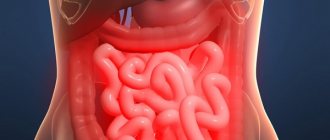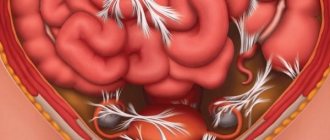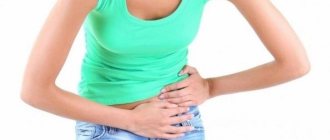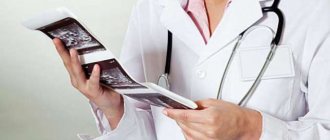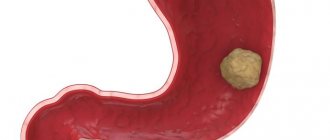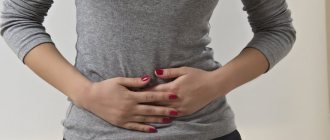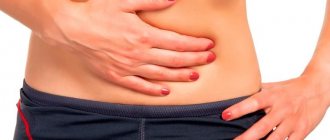Why does the stomach hurt when pressed: reasons, what to do
During a medical examination, the doctor checks how the abdomen feels to the touch, where discomfort occurs during palpation, that is, when pressing on the abdomen, palpating.
This is done to identify the clinical sign - pain. If the patient himself feels the pain, the pain is detected by the doctor: the patient may not know what exactly he will feel when pressing on a certain area. The article will tell you about the causes of pain identified during self-examination by pressing on the front wall of the abdomen.
Topographic division of the abdominal cavity
They start by identifying the area in which the stomach hurts when pressed.
Doctors identify nine such areas. To detect them, the abdominal surface is conventionally divided by four lines located on the stomach, as in the game “Tic Tac Toe”. The first horizontal line runs directly under the ribs from right to left.
The second is from one ilium (the uppermost part of the pelvis) to the other, this line is located approximately where the elastic of panties usually ends up. Vertical lines are located to the right and left of the navel so as to divide the anterior surface of the abdominal cavity into three equal vertical parts.
This way we get nine parts equal in width.
We move from left to right along the upper “cells” of the abdominal zone:
- Left hypochondrium (bounded above by the ribs, below by the upper horizontal line).
- The epigastric region or epigastrium (has a triangular appearance: from above it is limited by the ribs and the xiphoid process of the sternum, from below - by the upper horizontal line).
- Right hypochondrium (bounded above by the ribs, below by the upper horizontal line).
We move from left to right along the second level of “cells” of the abdominal cavity, bounded from above by the upper horizontal line, from below by the lower horizontal line:
- Left side;
- Periumbilical;
- Right side area.
We move from left to right along the third, lower level, bounded from above by the lower horizontal line, from below and on the sides by the pelvic bones:
- Left iliac (looks like a triangle);
- Suprapubic (bounded below by the pubic bone);
- Right iliac (also triangular) region.
| Right hypochondrium | Epigastric (epigastric) region. | Left hypochondrium |
| Right side region | Periumbilical region | Left side region |
| Right iliac region | Suprapubic region | Left iliac region |
If you superimpose the zone of pain in abdominal pathologies onto the resulting “map,” each pathology reveals its own localization area.
| Cholecystitis; gallstones; pancreatitis; stomach ulcer. | Gastritis, stomach ulcer. | Diseases of the spleen. |
| Colitis; constipation. | Pancreatitis; appendicitis; gastritis. | Diverticulitis; constipation; colitis. |
| Appendicitis; gynecological diseases; duodenal ulcer. | Gastritis; gynecological diseases; inflammatory bowel diseases; appendicitis. | Diverticulitis; gynecological diseases enterocolitis; intestinal adhesions. |
The main causes of pain when pressing
Here are some of the possible pathologies that cause pain when you press your fingers on your stomach. For all pathological processes, pain on palpation does not become the only sign; it is important to pay attention to associated symptoms.
Acute gastritis
A common cause of pain when pressing on the umbilical and suprapubic areas is acute gastritis, in this case the stomach hurts. The disease is accompanied by symptoms:
- Nausea;
- Vomit;
- Diarrhea;
- Feeling weak;
- Grayish coating on the tongue;
- Increased salivation or, conversely, dry mouth;
- In some cases, a rise in body temperature.
It is important to confirm the diagnosis with a doctor, since pain when pressing fingers on the lower abdomen can indicate appendicitis.
Appendicitis
With appendicitis, pain becomes maximum when pressing on the right iliac part. During pressing, the discomfort does not reach its peak. It comes when the fingers are removed. This type of pain indicates a serious pathology and the need to urgently consult a doctor.
Stomach ulcer
When palpating the epigastric zone, a patient with a gastric ulcer will feel pain, accompanied by spontaneous tension of the abdominal muscles in this area. Muscle tension is felt especially well when you apply jerky pressure with your fingers on the stomach.
Duodenal ulcer
Pain when pressing on the right iliac zone, which is accompanied by spontaneous muscle tension, becomes a consequence of an advanced duodenal ulcer. In the early stages of the disease, there are no obvious pain sensations on palpation.
Pathologies of the spleen
Painful sensations on palpation are sometimes caused by an enlarged spleen.
It is strictly forbidden to press hard on the area where it is located: the spleen is a fragile organ, its rupture can occur due to inaccurate palpation.
If there is a problem with the spleen, a characteristic symptom appears - blueness of the skin surrounding the navel. The intensity of unpleasant sensations with an enlarged spleen can spread to the intestines due to its compression and displacement.
Gynecological diseases
In women, pain when pressing on the abdomen can occur with inflammation of the appendages (adnexitis), polycystic ovary syndrome. The focus of disturbing sensations is localized in the iliac and suprapubic regions.
Diverticulitis
Diverticulitis is an inflammatory disease that affects the intestines. With it, palpation of the left lateral, left iliac regions causes acute pain if you press on the source of inflammation. Painful sensations can intensify with physical activity, coughing, and laughter.
Cholecystitis
This is an inflammation of the gallbladder. In addition to pain in the area of the right hypochondrium, tapping the edge of the right costal arch with the edge of the palm helps to detect discomfort: with cholecystitis, such an action will cause severe pain that appears during tapping and disappears after the cessation of this action.
Pancreatitis
Palpation of pancreatitis, inflammation of the pancreas, is considered a complex procedure that is difficult to perform without special education. Pain is noticeable upon palpation six centimeters above the navel.
What to do after self-examination
If abdominal pain occurs during palpation, you should consult a specialist; only he can determine what caused the ailment. The doctor will conduct a professional examination, review the patient’s medical history, and ask questions about accompanying symptoms. A sick person may miss an important symptom; the doctor will definitely pay attention to it.
Based on the results of the examination and questioning, the patient will receive referrals for tests and additional examinations: ultrasound of the abdominal cavity, computed tomography, endoscopic examinations. If necessary, emergency surgery is prescribed.
How to deal with pressure pain
Self-medication is not recommended. Taking painkillers is especially dangerous. Pain, its nature and location are the main sources of information about what a person is sick with. Before a medical examination, taking analgesics is strictly prohibited!
The only thing allowed is to follow a therapeutic diet: exclude spicy, salty, fried foods, coffee and strong tea from the diet. Errors in nutrition themselves will cause pain in the abdominal cavity.
Drinking alkaline mineral water will ease the condition. Drinking should be plentiful, frequent, sips should be small. Drinking warm mineral water is indicated for patients with peptic ulcers of the stomach and duodenum.
If pain is caused not by a serious pathology, but by a functional disorder of the digestive tract due to overeating or stress, it is allowed to take Activated Charcoal or Smecta. To relieve spasms, an adult can take a couple of tablets of No-shpa and Drotaverine.
Source: https://GastroTract.ru/simptom/boli/pochemu-bolit-zhivot-pri-nadavlivanii.html
Types of pain and their symptoms
When contacting a specialist, you need to describe to him in as much detail as possible the nature of the pain that has arisen and the symptoms accompanying it. Reproduction of the clinical picture simplifies the diagnosis process.
Pulsating
They have a cramping character upon palpation and are a consequence of various deviations in the development of hollow organs and the subsequent increased load on them. They accompany an ovarian abscess, when the formed purulent masses are the source of painful pulsation.
Permanent
They are observed long-term – from 4 months and longer. They provoke neurological disorders. Mycoplasmosis or chlamydia are often detected. In medical practice, the origin of symptoms is associated with psychogenic factors.
Paroxysmal
The duration of the discomfort is at least an hour, the character ranges from cutting-pulling to sharp-aching. The condition indicates a potential ectopic pregnancy, ovarian rupture, inflammation of the appendages (adnexitis), and torsion of the cyst. Pain in the lower back. Refers to pain that requires immediate hospitalization.
The reasons for the localization of pain in the left lower abdomen indicate diseases of the left kidney or left side of the intestine, as well as the internal genital organs:
- Diverticulitis. If detected late, it causes perforation of the sigmoid colon.
- Urolithiasis caused by the passage of stones through the urinary tract.
- Adnexitis.
- Worm infestation.
- Inflammation of the sigmoid colon.
- Inguinal hernia strangulation.
- Tubal pregnancy.
- Granulomatous enteritis.
- Ulcerative colitis.
A comprehensive examination of the entire abdominal cavity will allow the pathology to be correctly diagnosed. If the epicenter of pain is in the lower right side, there is a high probability of appendicitis. Etiology may also include: ulcerative right-sided colitis, cholecystitis, terminal ileitis, pyelonephritis, cancer, salpingitis. Less commonly – intestinal herpes, endometrial polyp, inflammation of the right ureter.
Gives to the lower back
Pelvic pain affects the sacrum, lower back, and often shifts to the vaginal area. Acute pain in the lumbar region with high fever and general weakness of the body occurs with appendicitis, megacolon, pyelonphritis, cholecystitis, rupture of an ovarian cyst or inflammation of the urethra. This condition of a woman can be caused by multiple reasons:
- gynecological
- psychogenic
- proctological
- urological
- vascular
- neurological nature
Chronic pain in the lower abdomen radiating to the lumbar region indicates the presence of a hidden disease, which must be stopped as soon as possible.
Such pain in a woman is not considered physiologically normal. They often manifest as rupture of the fallopian tube, ectopic pregnancy, and inflammation of the pelvic organs. The listed diseases require prompt medical intervention.
Natural pain
Includes the period of ovulation, menstruation, and also after childbirth (approximately 5-7 days). Some women are susceptible to psycho-emotional factors. As a consequence, the stomach may hurt, which is a neurological manifestation of vegetative-vascular syndrome.
Along with pain in the lower abdomen, the following may occur:
- Diarrhea, vomiting, fever, which occurs with inflammation of the appendages.
- Curdled vaginal discharge - with candidiasis, sexually transmitted diseases, long-term use of antibiotics or contraceptives. Lack of timely treatment can provoke cervical erosion.
- High temperature is a sign of hyperthermia, characteristic of ulcerative processes, dysentery, diverticulitis, cholecystitis, even venereal diseases. An increase in temperature above 38°C is an indicator of septic infection of the body. The condition occurs with peritonitis, apoplexy of an ovarian cyst, rupture of the abdominal aorta or fallopian tubes.
Hypothermia within 34-35°C is a harbinger of internal bleeding, an indication for prompt medical intervention.
Symptoms of pain in the lower abdomen upon palpation
During a medical examination, the doctor checks how the abdomen feels to the touch, where discomfort occurs during palpation, that is, when pressing on the abdomen, palpating. This is done to identify the clinical sign - pain. If the patient himself feels the pain, the pain is detected by the doctor: the patient may not know what exactly he will feel when pressing on a certain area.
The article will tell you about the causes of pain identified during self-examination by pressing on the front wall of the abdomen.
What to do if you have frequent pain
If nagging pain is associated with functional causes, in particular when it occurs before or during menstruation, then you can cope on your own. With a mild, nagging pain syndrome, you can simply endure the discomfort. To quickly stabilize the condition, you can take a painkiller or antispasmodic drug.
If the pain occurred once and disappeared within a couple of hours, and after that it did not arise again, then you can do nothing. More dangerous are constant nagging pains in the lower abdomen. In such cases, it is necessary to consult a doctor as soon as possible.
Pain on palpation of the abdomen: causes, diseases, symptoms
If your stomach hurts when pressed, you can understand what exactly triggered the appearance of this symptom by undergoing an examination by a specialist and diagnostic measures, or you can try to independently understand the cause of the pain, knowing the nature of the pain in specific diseases.
The anatomical location of the stomach suggests its projection onto the epigastric region (the upper abdomen between the costal arches, under the xiphoid process and above the navel), but there are exceptions: prolapse of the stomach in athletes, adolescents, people of asthenic physique or prolapse caused by pathological changes, then pain can be observed and below the navel or with a shift to the right. In addition, pain in pathologically altered abdominal organs, including the pancreas, liver, gallbladder, small and large intestine, may be observed in the epigastric region. Therefore, we will try to figure out what and how can cause pain when pressing on the abdomen at the presumed location of the stomach. First of all, it is necessary to establish exactly when pressure on the stomach causes pain: before eating or during meals, when bending over, walking, or at rest. What is the nature of the pain: aching, dull, cramping or stabbing? Many people periodically experience discomfort in the epigastric region. It can be caused by both functional (functional dyspepsia, pylorospasm, gastrostasis, biliary dyskinesia, irritable bowel syndrome) and organic changes in the gastrointestinal tract and abdominal organs (gastritis, gastroduodenitis, gastric ulcers, duodenal ulcers, pancreatitis, cholecystitis).
Pain that occurs in the stomach area is called “gastralgia” in medical terminology. This symptom
characterized by a variety of pain sensations: cramping, burning, pulling or pressing in the epigastric region. Mainly observed in various pathologies of the stomach, duodenum, gallbladder, pancreas, small and large intestine.
Classification of pain according to diseases that cause pathological changes in the abdominal organs with a projection on the anterior wall of the abdomen.
- Cramps or colic. They are provoked by a spasm of the smooth muscles of the organ during its inflammation. They are acute, paroxysmal in nature and require emergency assistance. Types of colic: hepatic, renal, gastric, pancreatic, intestinal.
In case of a functional disease, colic manifests itself in the form of “irritable bowel syndrome”; in case of intoxication, it manifests itself in the form of “lead colic”.
- Pain when stretching hollow organs (stomach, gall bladder) is dull and aching.
- In case of circulatory disorders in the peritoneum (the nature varies depending on the degree of ischemia: from moderate to critical): angiospastic and stenotic in nature.
- Pain due to inflammation of the abdominal membrane (peritonitis phenomena, usually complicated by bleeding, perforation, penetration of peptic ulcer).
- “Mirror pain” – the pain radiates to another area, distant from the location of the pathologically altered organ.
Pressing on various areas of the abdomen and the occurrence of pain indicate possible pathological changes in the organs located there:
- Epigastric: disease of the stomach, duodenum, liver, gall, pancreas.
- Periumbilical (periumbilical): inflammation of the blind section of the large and small intestine.
- Hypogastric (lower abdomen): disease of the colon and organs located in the pelvis.
According to the mechanism of occurrence, pain is classified into:
- Visceral.
- Parietal.
- Irradiating.
- Psychogenic.
Visceral pain occurs due to the presence of an inflammatory focus in the stomach or intestines. It feels like a dull pain when pressing on the stomach, the strength of its action changes and weakens after a while. It is concentrated inside the abdominal cavity and often radiates to other places. With it, autonomic reactions can be observed: sweating, pale skin, increased heart rate.
Somatic pain occurs when there is damage to the abdominal wall or appendicitis, and is more intense than visceral pain. It intensifies with movement of the diaphragm and coughing, and it can hurt in:
- epigastrium: for pancreatitis, cholecystitis, gastric ulcer;
- right upper part: cholestasis, hepatitis, biliary dyskinesia, hepatitis;
- left upper section: pancreatitis;
- lower right: appendicitis, lymphadenitis, diverticulitis;
- left lower part: disease of the sigmoid colon.
Irradiating (mirror or radiating). This is visceral pain, which is reflexively transmitted to nearby tissues or bone from the pathological focus.
Psychogenic is diagnosed when other types of pain are not objectively confirmed and there is a visible psychological
the soil for their emergence. The main cause is depression. This is explained by a violation of general biochemical processes in the regulation of the nervous and digestive systems.
The pain in such cases is felt as monotonous and prolonged.
At the same time, according to patients, everything can hurt: the head, the back, there is aches throughout the whole body, that is, other symptoms appear without the presence of pathological changes in them.
Stages of pain:
- Acute – a sign of acute surgical pathology, injury or infection.
- Chronic – recurring pain of different nature during inflammatory processes.
- Recurrent. It subsides during the treatment of the inflammatory focus and occurs again when the disease recurs.
The forms of pain can be varied:
- Acute, cramping.
- Stitching pain.
- Cutting.
- Dumb.
- Sucking.
- Aching.
- Pulling.
- Pressing
- Bursting.
Etiology and elements of the pathogenesis of pain
According to the teachings about the physiological components of pain, it is considered as irritation of receptors in the serous membrane, skin, and muscles. It is provoked by an inflammatory process or lack of blood supply, obstruction of patency in the cavities, sudden stretching or, conversely, narrowing of the organ.
The reasons why the stomach may hurt when pressed may be the following:
- Inflammatory process in the organs of the digestive system: gastritis, pancreatitis, cholecystitis, hepatitis, colitis.
- Appendicitis, urinary tract infections, ulcers complicated by perforation, bleeding, acute intoxication due to pancreatitis.
- Mechanical narrowing of the bile-urinary ducts.
- Thrombosis of organs and blood vessels.
- Mechanical trauma to the peritoneum.
- Violation of intestinal digestion and absorption of food.
- Gynecological inflammatory diseases.
- Intestinal adhesions after surgery.
How to properly clean your belly
Most people train their abdominal muscles to lose belly fat.
However, such efforts may not bring the desired results.
Zonal influence may not be effective
It is a mistake to believe that exercising only a certain area of the body will help burn fat in that particular area.
Source: https://polic-5.ru/simptomy/pri-nazhatii-na-zhivot-bolno.html
Causes of appearance and accompanying symptoms
Painful sensations in the lower abdomen can be divided into organic and functional pain. This method of separation depends on the cause that influenced the appearance of cutting pain. Often, this symptom indicates that a negative process is occurring in the human body, which should be treated as soon as possible.
There are 4 main common causes of this ailment, which do not depend on gender, age or other factors. Common causes of illness:
- Appendicitis, which can cause severe pain. Often an attack of appendicitis is accompanied by cutting pain in the right side of the peritoneum; the pain can be stabbing, depending on the degree. It may be accompanied by attacks of nausea, vomiting or fever.
- Intestinal obstruction is characterized by preliminary bloating, attacks of diarrhea, nausea, heartburn, and increased gas formation. Pain appears from the left lower part of the peritoneum, but sometimes its localization changes and its severity intensifies.
- Presence of stones in the bladder. This disease is often accompanied by a frequent urge to urinate.
- Pain in the left lower abdomen may be characterized by virculitis.
- An attack of strangulation of a hernia in the groin area. This phenomenon can be characterized by diarrhea and vomiting.
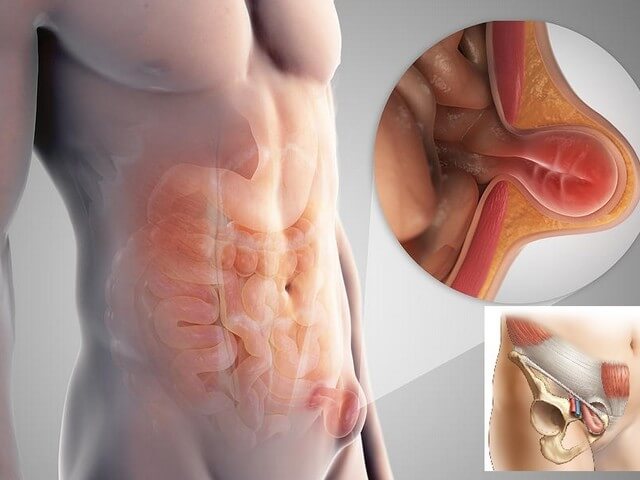
Doctors have found out what is the most effective remedy for worms! According to statistics, every 5 Russians have worms. Read on for a recipe that will help cleanse your body of worms in just 7 days.
All attacks of pain can be constant, pulsating, strong, acute, paroxysmal in nature. There is a specific remedy for each type of pain; it is important to know the cause of the pain in order to choose an effective medicine.
All causes of pain in the abdomen upon palpation
What does pain on palpation of the abdomen on the right indicate? First, you at least need to do an ultrasound. Secondly, if abdominal pain occurs upon palpation, more on the right - this is a sign of inflammation or indigestion.
Basic knowledge
It’s difficult to determine, I speak as a surgeon with 5 years of experience. First of all, you need to eliminate the worst. The worst I consider:
- Acute appendicitis. The appendix may be located near the liver, between the liver and the right iliac fossa, near the bladder, or even near the kidney. In all cases there will be pain on palpation in the right abdomen. You can read more in this article: https://www.med-side.net/ostryj-appendicit-u-detej-i-vzroslyx-vrach-xirurg-dal-vse-otvety/.
- Cholecystitis. If it is acute and associated with damage to the gallbladder, it threatens with bile peritonitis, a bunch of tubes in the abdomen, and adhesive disease. Therefore, if it hurts just under the rib, there is bitterness, the sclera of the eyes has turned yellow - see a doctor immediately. He will order an ultrasound and check the blood for bilirubin and determine leukocytosis.
- Bowel cancer. There is a peculiarity with cancer. It hurts constantly, but not much. The pain increases over time. After about 6-9 months, when the tumor grows, it can hurt very much, but at the same time constipation begins. A doctor’s consultation and instrumental diagnostics are inevitable. https://oncologystinfo.com/jkt/top-metodov-rannej-diagnostiki-i-skrininga-okolorektalnogo-raka-zashhitit-sebya-prosto/
- Banal indigestion. May be caused by an intestinal infection or overeating. It is characterized by the fact that the abdomen is very swollen, and upon palpation it hurts everywhere. You need to give antispasmodics and do a cleansing enema, then it will become more clear what’s what. https://www.med-side.net/prichiny-meteorizma-chto-delat-pri-vzdutii-zhivota/
- Intussusception. In children this happens from 6 to 9 months. It manifests itself as a cry against the background of the fact that a moment ago the child was absolutely calm. Everything about intussusception is written very clearly in this article. Intussusception can also occur in adults; this is also associated with the growth of a tumor or polyps in the intestine. Read the article I’m pointing to, everything is clearly described there. https://www.instagram.com/p/B6Jm4sIHa9h/
- Renal colic. It is characteristic that attacks of pain appear during active pastime. As a rule, the cause is a stone entering the ureter and blocking the kidney, as a result of which intrarenal pressure increases and pain appears in the right or left half of the abdomen. The pain intensifies with deep palpation, it hurts very much if you tap the kidney with the edge of your palm. The so-called Pasternatsky symptom. In this case, be sure to see a doctor.
- Ovarian diseases. In women, pain on palpation in the right abdomen may be due to bleeding from the ovary, this is called apoplexy. The second option is torsion of the ovarian cyst or rupture of the cyst. Pain during palpation in the right lower abdomen in women may indicate a disruption of the hormonal relationship between progesterone and estrogen. This often happens due to polycystic ovary syndrome.
- Pain on palpation in the lower abdomen in men or boys can occur with testicular torsion or torsion of the hydatid of Morgagni. Therefore, the surgeon always examines the scrotum, especially in children. In my practice, there have been cases when a child with a stomach like appendicitis was admitted to the operating room for surgery for testicular distortion.
Why did I write so much information? Moreover, it is very difficult to diagnose and determine the true cause of pain in the right abdomen without specialized instrumental and laboratory tests.
At a minimum, you need to do a general blood test, liver tests, ultrasound, and even x-rays with or without contrast. Don't let your stomachs go. If pain occurs, run to the doctor's emergency room or clinic.
In the first 5 situations described above, time passes in hours, not days.
If it cuts and stings in the right abdomen, what else should you pay attention to?
Pain is a compensatory reaction. All organs in the abdomen are covered by peritoneum. It lines the organs inside and out. When inflammation occurs, irritation of the peritoneum also occurs. It immediately stimulates abdominal muscle spasms.
As a result, not only local pain appears in the abdomen upon palpation, but also muscle tension. The stomach becomes hard.
With appendicitis, this is a triad: pain, tension in the abdominal muscles and an increase in body temperature to 37-37.5 degrees.
If the abdomen is soft, but there is local pain on palpation in the right abdomen, this does not exclude surgical pathology. You always need to monitor dynamics. This is especially important for children, since for them everything does not happen according to the “classical” version.
Why does it hurt in the right abdomen due to women's problems?
The entire abdomen has nerve connections between each other. Soreness in one area can lead to soreness in another. This is called pain radiation. This also happens with pain in the heart, when it radiates to the arm or lower jaw. Therefore, do not self-medicate!
Does it hurt on the right side with an ulcer?
Yes, pain in the right abdomen during palpation can occur with a peptic ulcer. But this is not just one symptom. You should pay attention to the time when pain appears. If it is pain 2-3 hours after eating, you most likely have an ulcer. But this is not 100% of cases; to confirm the diagnosis, an FGDS must be done.
I want everyone to understand that diagnosing and treating diseases is not easy. Not every doctor can immediately make the correct diagnosis. Therefore, you should not search for a disease on the Internet. Read the information and draw conclusions that if it hurts, it’s better to see a doctor.
= =
Source: https://www.med-side.net/vse-prichiny-poyavleniya-boleznennosti-v-zhivote-pri-palpacii-razbor-poletov/
Possible causes of nagging pain in women
In gynecological practice, one type of pain syndrome can manifest itself in over a dozen pathologies.
They are similar in clinical manifestations, sometimes causing the need to take an analgesic to improve the condition. The most common cause of lower abdominal discomfort in women is related to menstruation. The painful period is complicated by the pressure of the bladder on the uterus. Potentially aggravating the patient's condition:
- being in a stressful environment
- empty stomach cramps
- drinking alcohol or strong coffee on an empty stomach
- intimacy
- lifting weights
- insomnia caused by unpleasant sensations
https://www.youtube.com/watch?v=GYRUPwsafbg
Discomfort is felt with intestinal overcrowding, constipation and subsequent complications (for example, colon diverticulosis). Abdominal pain in women in the 2-3 trimester of pregnancy is explained by stretching of the abdominal muscles. Factors that provoke pain in the lower abdomen include pathologies of the genitourinary system, pelvic organs, and malignant neoplasms.
These include inflammation of the uterus, ovaries, vagina, and fallopian tubes. Particularly dangerous conditions are included in the definition of “acute abdomen”.
The following pathologies cause pain and serious health consequences:
- Ovarian cyst. Intra-abdominal rupture of this neoplasm is accompanied by unbearable pain, often with loss of consciousness. Until emergency hospitalization, it is advisable to limit physical activity, which will help stop bleeding.
- Torsion of the uterine appendages. Diagnosed exclusively in women of reproductive age. Changing their position on the capillary base, torsions destabilize blood flow and cause acute pain with variable intensity. Accompanied by vomiting and nausea. Often, a dermoid active teratoma of the ovary is subsequently discovered. Dermoid consists of compacted connective tissue of a round shape with a mucous consistency inside. It is an indication for cystectomy, in the worst case – for wedge resection or oophorectomy.
- Chronic adnexitis, genital prolapse, preserved ovary syndrome. They cause dull, recurrent pain symptoms.
- Benign neoplasms in the muscular lining of the uterus: endometriosis of all histological varieties, fibroids. Compression of adjacent internal organs and pathological processes of the cyst itself cause symptoms of fibromyoma. Non-cancerous myometrial tumors cause the formation of secondary dysmenorrhea. With it, pain becomes systematic. Otherwise, the pain becomes unbearable, causing loss of ability to work and the need for emergency hospitalization.
In addition to pain in the lower abdomen, the above pathologies are accompanied by discharge, elevated body temperature, and fatigue. The diagnosis is confirmed by blood and urine tests: high levels of leukocyte volume indicate the presence of inflammatory processes.
Pain is contrary to the full health of mother and child during pregnancy. It is necessary to differentiate your own sensations, determine the irradiation of discomfort that may arise during the development of:
- Ectopic pregnancy. If the pain is strong, cramping, up to loss of consciousness, with localization at a specific point and minor discharge. This condition is characterized by a sharp drop in blood pressure. There is a risk of rupture of the fallopian tube from 7 to 12 weeks, when pain spreads under the ribs or to the anus.
- Threatened miscarriage. If the pain is aching in nature, radiating to the lower back, lasts for several hours, accompanied by bloody discharge. In case of sudden attacks, the patient must be hospitalized immediately. Premature termination can be triggered by stressful situations, various types of trauma, physical activity, and fetal diseases.
- Flatulence, constipation or megacolon, if frequent pain in the lower abdomen is preceded by an incorrect diet. The diagnosis is confirmed by nausea or heartburn, vein thrombosis in the rectal areas. Such conditions prevent the full development of pregnancy, so it is recommended to carefully optimize the diet.
- Placental abruption. If the pain is very strong, increasing, and does not allow you to take a vertical position of the body. The lower abdomen is tense, and the risk of intrauterine hypoxia and subsequent death of the child is high. In this case, immediate medical attention is required.
- One of the pathologies from the “acute abdomen” group (pancreatitis, appendicitis) with the need for immediate medical intervention.
Natural pain, in which the health of the mother and child is not threatened, develops in the early stages of pregnancy, when the belly grows. The muscles stretch, the uterus increases in size, and the internal organs shift slightly. These factors lead to some discomfort, but this should also be reported to the observing gynecologist.
Diseases of the genitourinary system are accompanied by pain above the pubic bone, radiating to the right or left side. Some tension or pressure, frequent urination, change in urine color indicate the presence of one of the diseases:
- Cystitis. It is characterized by a false urge to urinate (there is no feeling of complete emptying), aching sensations in the lower abdomen, and, less commonly, urinary incontinence. The clinical picture is complemented by general malaise, fever, and in chronic cases there is an admixture of blood in the urine.
- Chronic pyelonephritis. The pathology worries patients in the winter with excruciating pain in the lower abdomen and lower back. Developing discomfort, high fever, headache, fatigue, and hypertension are common causes of insomnia. Urine contains an admixture of pus.
- Stones or sand in the bladder, kidneys (urolithiasis). Concretions grow on the inner walls and are able to move along the passage of the genitourinary system. This process causes an attack of renal colic. The pain intensifies when stones are fixed inside narrow channels. A sudden urge to urinate can occur with any increase in physical activity. But urinary retention is often observed due to blockage of the ureter by a stone.
- Urethritis. It is an inflammation of the urethra due to the penetration of pathogenic microflora (Trichomonas, staphylococcus) into the body. The main symptom is a burning sensation when urinating, purulent discharge from the urethra.
The listed pathologies can be combined - in the absence of adequate treatment for a long time, one disease becomes the cause of the appearance of another. In this case, signs of intoxication are observed - weakness, increased body temperature, chills.
Congenital diseases of the female reproductive system entail frequent discomfort, with sharp outbreaks and fading pain. These include:
- Abnormal development of the genitals
- Complete absence of an internal organ or any part thereof
- Disproportionality of shapes and sizes of organs
- Narrowed cross-sectional diameter of a hole or channel
- Presence of unnatural formations
A woman may not be aware of some anomalies until she undergoes an ultrasound, where the presence of the feature is detected.
The causes of inflammation of the abdominal organs are the entry of pathogenic microflora into the blood, infection of the stagnant biological environment by them. Less commonly, movement of the pathogenic environment from other parts of the body (genitourinary, ENT organs).
A more threatening condition is total inflammation of the entire abdominal wall (peritonitis), the development of which is facilitated by:
- Perforation of the inflamed appendix, in which immediate surgical intervention is inevitable. Diffuse pain near the navel moves to the iliac region. The condition is accompanied by leukocytosis.
- Ulcerative lesion of the duodenum or stomach, subsequent perforation of the walls of the problem organ, entry of the contents into the abdominal cavity.
- Violation of the integrity of the intestinal walls due to a physical puncture, if the swallowed object has sharp edges,
- Rupture of a tumor or diverticulum (protrusion) of the intestine.
- Infection during surgery or during the postoperative recovery period.
- Abdominal injuries.
Pain during peritonitis does not have a specific localization; it intensifies with movement, as well as during sneezing or coughing. If proper treatment is not carried out, then the death of nerve receptors is quite likely. In this case, there will be no pain at all - this condition is caused by necrosis.
Symptoms are complemented by vomiting, nausea, lack of intestinal motility, pale and dry skin, tachycardia, and decreased blood pressure. The body position - with knees bent, pressed to the stomach - allows you to somewhat reduce discomfort. Complications include panic attacks, seizures, even loss of consciousness or coma.
Young women who have not yet given birth often have unstabilized hormonal levels. This imbalance is what causes period pain. The discrepancy between the volume of prostaglandins produced and the level of progesterone is the cause of an increased number of uterine contractions, headaches, nausea, weakness of the body, irritability, and possibly vomiting.
When all organs are fully functioning, menstruation does not cause pain. The exception is cases of incorrectly installed intrauterine device. Pain in the lower abdomen that occurs in mature mothers during menstruation is a manifestation of endometriosis or inflammation of the ovaries.
Other factors
Include gastrointestinal diseases, adhesions formed after surgery, colon pathologies - ulcerative colitis, Crohn's disease. Diverticulosis is more common in older patients. In addition to pain in the suprapubic region, it is accompanied by fever, bloody diarrhea, and an increased level of leukocytes in the blood.
There is no pain when palpating the abdomen
During a medical examination, the doctor checks how the abdomen feels to the touch, where discomfort occurs during palpation, that is, when pressing on the abdomen, palpating. This is done to identify the clinical sign - pain. If the patient himself feels the pain, the pain is detected by the doctor: the patient may not know what exactly he will feel when pressing on a certain area.
The article will tell you about the causes of pain identified during self-examination by pressing on the front wall of the abdomen.
Preventive measures
As a preventive measure, it is recommended to visit a doctor once every 6 months. These visits should not depend on the presence or absence of lower abdominal pain. You should lead a healthy lifestyle and avoid swimming in cold waters. Limit the consumption of alcoholic beverages; quitting smoking will bring no less benefit. You should monitor your diet, as some pathologies directly depend on the food a person eats. You should carefully monitor your health and avoid colds. A mandatory measure is to take medications or vitamins to strengthen the immune system. You should pay attention even if you don’t cut much.

Hygiene rules must be observed. This rule applies not only to everyday moments; hygiene is needed before sex and after sexual intercourse. Sexual life includes safety rules, since sharp pain occurs due to carelessness, use of contraception, and avoidance of casual sexual intercourse.
These precautions cannot completely protect a person from the occurrence of pathologies; they significantly reduce the risk of diseases. Therefore, compliance with preventive measures is important for every person, regardless of the person’s gender, age or weight.
Among the listed pathologies, almost everything can be cured, it depends on the degree of neglect of the disease. It is not recommended to ignore abdominal pain. But it is important to remember that self-medication is extremely dangerous. It is better to consult a doctor if such signs appear, undergo diagnostic measures and begin effective treatment.
Pain in the lower abdomen is one of the most common symptoms with which people consult a doctor, and the sudden onset of severe, sharp pain in the abdomen often forces them to call an ambulance. This symptom is very nonspecific; in the vast majority of cases, an accurate diagnosis can only be made by a doctor based on examination and examination data. To make a diagnosis, the characteristics of the pain syndrome are important, such as the location of the pain, events preceding its onset, accompanying symptoms (nausea, vomiting, diarrhea, fever, etc.), the connection of the pain syndrome with pregnancy or the menstrual cycle in women. Separately, it is worth mentioning the localization of the pain syndrome: pain does not always occur directly in the projection of the affected organ, which also complicates diagnosis.
Sudden severe pain in the lower abdomen in both men and women most often occurs with diseases of the digestive and genitourinary systems. If such a symptom occurs, the following diseases can be suspected:
- Appendicitis is an inflammation of the appendix of the cecum, and very intense pain in the lower abdomen is the main symptom of this disease. The pain is most often localized on the right, however, with an atypical location of the appendix, the patient may complain of pain in the left or middle abdomen, radiating to the lower back or rectum. In addition, patients experience symptoms such as nausea, vomiting, fever, and chills.
- Acute intestinal obstruction can also cause acute pain in the lower abdomen, especially if the pathological process is localized in the lower intestines. The pain appears suddenly, most often it is cramping in nature, in addition, patients experience vomiting, bloating (gas does not pass away) and constipation.
- Acute urinary retention can occur as a result of urolithiasis, cancer of the urinary organs, and prostate adenoma in men. This condition is characterized by the appearance of pain in the lower abdomen, usually in the middle; the patient feels a strong urge to urinate and a full bladder, but cannot urinate on his own.
- A strangulated inguinal hernia is a condition that occurs suddenly, most often as a result of severe physical stress. At first, the pain is localized in the lower parts, and then spreads to the entire abdomen, and many patients cannot accurately determine its location. In the first hours after strangulation, loose stools may appear, and later, on the contrary, the passage of gas and stool stops. Another early sign of this disease is vomiting. The patient's condition deteriorates very quickly.
All these diseases threaten the health and life of the patient, so if such symptoms appear, you should immediately consult a doctor or call an ambulance. Most often, they require emergency surgical intervention, so self-medication is unacceptable, it can be fatal.
The conditions described above can occur equally in both men and women. Below we will look at diseases that cause sharp pain in the lower abdomen, associated with pathology of the genital organs and structural features of the genitourinary system in representatives of different sexes.
Pain in the lower abdomen; it hurts to sit
A frequently encountered dilemma is why the lower abdomen may hurt, which is associated with disturbing pain outbreaks in many women.
When the lower abdomen hurts in women, many factors can serve as a motivator, for example, the acute stage of the inflammatory process in the abdominal organs, weakened bone tissue of the spine or problems in the reproductive system.
If a woman’s lower abdomen hurts, a spastic contraction of the muscular tissue of certain intrauterine organs can also serve as a driving factor. Infectious and inflammatory development is also not excluded.
There can be many influencing factors that cause pain in a woman’s lower abdomen. Pain is also distinguished by its characteristic signs and location.
Determining the possible “root” of the attacks, taking into account the accompanying symptoms, will help eliminate unpleasant symptoms.
Severe pain in the lower abdomen in a woman, accompanied by bloody discharge from the genitals (excluding the onset of menstruation) may indicate diseases of the reproductive system. With such manifestations, it is forbidden to use self-medication; you should seek help from a gynecologist as soon as possible.
The doctor will be able to reliably determine the cause of the ailment and establish a diagnosis, as well as prescribe an appropriate course of medication. After all, only a specialist is able to adequately compare all the accompanying signs of the disease.
The “pulling” nature of the pain, moving to the pelvic area, which is accompanied by cold sweating or, conversely, increased temperature, indicates an infection of the organs in the pelvis.
Sometimes diseases of this system are accompanied by such unnatural discharge from the organs of the reproductive system as purulent yellow or bloody clots. When contacting a gynecologist, it is necessary to clearly explain all disturbing signs.
A woman has severe pain in her lower abdomen, causes
If a woman has pain in the right lower abdomen, and the pain becomes protopathic (continuous) in nature with increasing intensity, there is a high probability of infectious or fungal infection of the appendix, and the diagnosis of appendicitis cannot be ruled out.
Such pronounced symptoms require immediate consultation with a doctor to make a diagnosis. If appendicitis is confirmed, emergency surgery will be scheduled.
Pain in the lower abdomen in girls, which is accompanied by additional symptoms such as:
- frequent attacks of nausea and even vomiting;
- loss of appetite;
- unreasonable fatigue;
- drowsiness.
Such symptoms may indicate acquired diseases of the digestive system and require prompt examination by a gastroenterologist. There are times when it hurts to sit down and when moving it radiates to the lower abdomen, which can characterize hemoperitoneum (intra-abdominal bleeding). In this case, the following symptoms will be observed:
- pale skin, including mucous membranes;
- dizziness, to the point of fainting;
- weakness;
- low pressure;
- cold sweat;
- Back or shoulder pain may additionally occur.
Such indicators also require immediate examination by a doctor.
There are examples when a woman has pain in her lower abdomen, and shooting pains appear in the lumbar region, as well as frequent urination, in which macrohematuria (the presence of blood in the urine) is visualized in the urine. This is evidence of pathological processes in the urethra. With such symptoms, you need to contact a specialist called a nephrologist.
Pain in the very lower abdomen in pregnant women is a separate issue. If the pain is sharp, or even worse, acute, there is a possibility of an ectopic pregnancy. You need to know that even normal gestation may be accompanied by unpleasant but mild pain.
If the pain does not become permanent, then this should not cause unnecessary worry. Nagging pain in the lower abdomen occurs in almost every woman carrying a child.
But you should not ignore any discomfort; you need to notify your doctor about this, who, based on other indicators, will accurately determine the source of such signs.
Diseases of the digestive segment (most often the main symptom of diseases manifests itself in the form of problems with bowel movements) and diseases of the urethra of the infectious group can serve as a provocateur of pain. The only thing that will help here is not to miss the moment and timely contact a doctor to prescribe the correct treatment.
If we take into account only the category of pregnant women, then pain is divided into two classes: gynecological and non-gynecological. In the case when premature detachment of the placenta occurs, this pathology threatens miscarriage and causes obstetric pain.
To prevent this, a woman must follow a special regime:
- Minimize physical activity.
- Elimination of bad habits.
- Refusal to eat fatty and salty foods.
- Normalization of diet. It is best to eat more often - up to 6 times a day, but at the same time reduce the size of portions.
If the pain does not stop, but on the contrary, an exacerbation is felt, it is necessary to undergo a full examination to determine the exact cause of its occurrence.
When a pregnant woman experiences a malfunction in her digestive system, resulting in pain in the lower abdomen, such pain symptoms belong to the non-gynecological group.
In many cases, a woman’s pain can appear suddenly and also suddenly go away; here we can talk about a chronic disease that was in remission and has now entered an acute phase. This is a signal that cannot be ignored.
There is a pain syndrome that is of an uncertain nature - visceral pain. A person cannot indicate its location.
There may be a feeling of nagging pain in the groin; the syndrome can change its location, moving to the right or left.
If pain in the lower abdomen occurs for the first time, it is better to contact a specialist for examination, because an unpleasant symptom can signal the presence of a serious disease and identifying it in the early stages greatly facilitates treatment and affects its positive outcome. Chronic diseases such as ulcers, colitis, gastritis provoke the appearance of cutting pain, and the acute phase of these ailments can serve as one of the reasons for the parallel development of other diseases, which in a complex clinical course of the disease can cause various kinds of complications.
Why is timely assistance from a specialist important?
Cold seasons are those periods when women most often report complaints of pain in the lower abdomen. In most cases, the problem occurs due to an inflammatory process in the pelvic organs.
A pathological process in the body indicates the acquisition of a viral disease, hypothermia or immunodeficiency - all these factors help to open full access for viruses to enter a weakened body.
50% of women with complaints of pain in the lower abdomen are of reproductive age from 25 to 35 years. Such symptoms are most often recorded during inflammation of the appendages (adnexitis) and uterus (endometritis and cervicitis).
An undiagnosed disease leads to progressive pain.
Therefore, if a girl has pain in the lower left abdomen, and a pain “response” is felt in the intestines or lower back, you should not put off going to the gynecologist.
When a young girl has pain in her lower abdomen, sometimes an additional symptom may be a nagging pain in the lower back; this may indicate the approach of the menstrual cycle. This kind of unpleasant syndrome is called dysmenorrhea. Mild pain relievers help suppress menstrual pain.
Ailments associated with gynecology, one of the symptoms of which is pain in the lower abdomen, are: uterine leiomyoma, acute and chronic endometritis, salpengitis, etc. Endometritis is the most commonly diagnosed gynecological disease.
The inflammatory process begins in the mucous membranes of the uterus and quickly spreads to other areas. Pain syndrome with endometritis is initially characterized by aching in nature, and radiates to the sacral area and lower back.
The further course of the disease is acute, which can be avoided by promptly seeking help from a medical institution.
Important facts
It is not uncommon for a woman to have pain in the lower abdomen that is not at all associated with gynecological procedures, such as abortion or childbirth; the cause may be an infectious disease that is sexually transmitted, for example, diseases such as chlamydia and gonorrhea.
During pregnancy, pathological processes that provoke pain symptoms in the lower abdomen are also possible.
Such pathogens include ectopic pregnancy, which is characterized by the placement of the fetus outside the normal fetal sac. The pain occurs suddenly, with movement, and has an increasing character.
A complication of this disease is a violation of the integrity of the fallopian tube. In this case, the pain is sharp and appears suddenly.
Cystitis and kidney stones can also cause pain in the lower abdomen. Intestinal obstruction is manifested by pain in the umbilical area, gradually descending to the groin.
To summarize, we can say that there can be many reasons for pain in the lower abdomen, so making a diagnosis yourself and self-medicating will be more expensive for your own health than contacting a good specialist.
A woman should be able to take care of her own health, because most diseases often carry complications, and such clinical development of the disease occurs only due to incorrect or untimely treatment.
Therefore, if pain in the lower abdomen has become a regular unpleasant companion, you should not use the advice of friends, it is better to undergo an examination in a specialized medical institution and identify the true cause of the pathological manifestations. Modern medicine is equipped with a sufficient number of tools for effective diagnosis and treatment of almost all diseases. Don't forget the golden rule: "Everything is good on time." Therefore, measures taken in time promise a speedy recovery.
Source: https://sfmggu.ru/bol-niz-zhivota-bolno-sidet/
Which doctor should I contact?
In case of acute pain in the lower abdomen, you should call an ambulance, which will take the patient to a surgical hospital. If acute surgical pathology is excluded, you should contact a urologist, and pregnant women should consult an obstetrician-gynecologist.
Sharp pain in the lower abdomen at one time or another in life bothers every person.
However, for some, the malaise is explained by banal overeating, and after some time it goes away on its own, while others, having experienced extreme torment, are forced to lie under the surgeon’s scalpel in order to save their lives.
The thing is that there are many causes of painful sensations in the lower abdomen: from the most harmless to life-threatening.
Therefore, everyone should be able to determine the nature (pulling, stabbing pain or cutting sensations reminiscent of contractions) and localization of discomfort in the lower abdomen.
Lower abdomen hurts when walking and other physical activity
The organs in the abdominal cavity are located in such a way that even with heavy physical activity and sudden changes in body position, they continue to function normally. However, with some physiological conditions and diseases, very unpleasant symptoms may appear: the lower abdomen hurts when walking, after lifting weights, when sitting down, and in general with any movements.
Typically, two groups of patients face this problem. The first is people suffering from urolithiasis. In severe cases, any movement can provoke the movement of the stone, and this, in turn, leads to renal colic.
The second group of patients are pregnant women, in whom serious physical activity can result not only in pain, but also in severe complications.
Pain in the lower abdomen when walking? Check your kidneys
Very often, discomfort in the lower abdomen that occurs when walking and running becomes the first sign of urolithiasis (nephrolithiasis). At rest, the stones are quietly located in the urinary tract and do not manifest themselves in any way. However, the slightest shaking can cause the movement of stones along the ureter, which is clinically manifested as renal colic :
- Severe pain in the lower abdomen, often radiating to the perineum.
- Aching and pulling sensations in the lower back.
- Decreased urination frequency and urine volume.
- Chills, sometimes fever.
After the end of the attack, that is, when the stone passes into the bladder, the painful sensations subside and the patient releases a large amount of urine, often colored red due to blood (due to injury to the ureter).
In patients with urolithiasis, sharp pain in the lower abdomen can occur even when sneezing, but, as a rule, it is shaking that provokes an attack (for example, on a bus).
If you suspect you have urolithiasis, you should consult a urologist or nephrologist. The doctor will prescribe a set of examinations, including ultrasound of the kidneys and detailed urine tests, and will also prescribe a course of treatment.
Modern medicine can treat nephrolithiasis using conservative methods, but in difficult cases (for example, large stones that pose a danger to the kidney), surgery may be required.
Pregnant? Limit physical activity
Pregnant women very often complain that their lower abdomen hurts, especially when walking for a long time and after lifting weights. This is a truly unpleasant symptom that limits daily activity, but in many cases its occurrence is quite natural.
The fact is that the growing uterus somehow puts pressure on the organs and tissues surrounding it. During walking, the structures of the abdominal cavity shift somewhat relative to each other and the degree of pressure on them from the pregnant uterus also changes.
In the later stages, this is accompanied by the movement of the baby to the entrance to the pelvis - due to the fact that it puts pressure on the cervix from the inside, the woman experiences a pulling sensation in the lower abdomen.
You should consult a doctor as soon as possible if pain in the lower abdomen when walking is combined with:
- Bloody discharge from the genital tract.
- Increased body temperature.
- Pulling sensations in the lower back.
- Severe weakness, nausea.
These signs indicate a threat of miscarriage and premature birth, and in order to save the life of your child, you should urgently call an ambulance.
Does your lower abdomen hurt when you sit down? Back problem
Some patients experience pain in the lower abdomen when they try to sit down. As a rule, this is due to banal osteochondrosis - a chronic disease of the spine, accompanied by the slow destruction of the vertebrae and intervertebral discs.
Lumbar osteochondrosis
Osteochondrosis is an insidious pathology that can manifest itself under a variety of masks. It happens that patients are admitted to the hospital with suspicion of acute appendicitis and even peritonitis (inflammation of the peritoneum). And after examination it turns out that problems with the spine were to blame.
A characteristic feature of osteochondrosis is the occurrence of herniated discs. These are protrusions towards the spinal canal, which mechanically compress the nerve roots and spinal nerves. Clinically, this is manifested by pain of various localizations, but their most important feature is dependence on body position .
For example, a patient may literally be unable to feel pain when he stands up straight, but when he lies down in the fetal position, the hernia stops putting pressure on the nerve and the pain goes away. Discomfort may even increase with sneezing and coughing.
Osteochondrosis requires long-term and complex treatment, including massage, therapeutic exercises, moderate physical activity, physiotherapy, drug therapy and others. For disc herniations, the most effective thing that modern medicine can offer is their surgical removal.
There are other causes of pain during physical activity, playing sports, walking and lifting weights. In particular, you should never forget that discomfort can occur after ordinary intense training and overexertion of the abdominal muscles. In difficult cases, be sure to consult a doctor.
Source: https://zhivotu.net/bolit-niz-zhivota-pri-hodbe/
